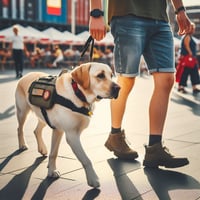Discover essential safety tips and guidelines for being a responsible dog walker when walking other...
Understanding Your Dog’s Drives: The Key to Better Behavior, Training, and Companionship
Dogs aren’t blank slates—they’re born with deeply ingrained tendencies that influence how they interact with the world. These behaviors, called “drives,” are the result of thousands of years of genetic evolution and selective breeding. Whether you're adopting a dog from a shelter or raising a puppy from a breeder, understanding these innate drives can dramatically improve your success in training, bonding, and managing your dog’s behavior.
In this blog post, we’ll break down the most common canine drives—including prey drive, hunt drive, defense drive, and pack drive—and explain how each affects your dog’s behavior and training. We’ll also explore what these drives mean in a modern, urban home setting, and how rescue adopters can better manage dogs with strong genetic tendencies.
What Are “Drives” in Dogs?
In canine behavior, a drive is a biological impulse or instinct that motivates a dog to behave a certain way. These are not learned behaviors—they’re hardwired survival tools, passed down through generations. Different breeds were historically selected for different jobs, such as herding, guarding, retrieving, or hunting. As a result, breed type and lineage play a huge role in drive intensity.
Understanding these drives helps you avoid mislabeling behavior as "bad" or "aggressive" when it’s really just a strong, unfulfilled genetic impulse.
The Most Common Genetic Drives in Dogs
🐾 1. Prey Drive
Prey drive refers to a dog’s instinct to chase, catch, and sometimes kill moving objects. It’s seen in many breeds, especially terriers, sighthounds, herding dogs, and even some toy breeds.
Behaviors include:
-
Chasing cats, squirrels, or bicycles
-
Lunging at fast-moving objects
-
Pouncing or stalking during play
Management tips:
-
Use flirt poles and structured games to simulate a "chase" safely
-
Avoid off-leash play in areas with small animals
-
Focus on impulse control exercises like “leave it” and “watch me”
🧠 2. Hunt Drive
Hunt drive is different from prey drive—it’s the instinct to search and locate, often without necessarily engaging in the chase or kill. This drive is strong in scent hounds like Beagles or Bloodhounds.
Behaviors include:
-
Nose glued to the ground on walks
-
Escaping the yard to track smells
-
Following a scent trail obsessively
Management tips:
-
Use nose work or scent games to satisfy this need
-
Provide long leash walks to allow natural sniffing
-
Reinforce a solid recall with high-value rewards
🛡️ 3. Defense Drive (Fight or Flight)
This is the dog’s instinct to protect itself or its resources, often misinterpreted as aggression. It includes both fight (confrontation) and flight (avoidance) responses.
Behaviors include:
-
Barking at strangers or other dogs
-
Reacting when cornered or touched unexpectedly
-
Guarding food, toys, or people
Management tips:
-
Never punish defensive behavior—acknowledge it and redirect
-
Build trust with positive reinforcement and controlled exposures
-
Muzzle train for safety during rehabilitation
🐕 4. Pack Drive
Pack drive is a dog’s desire to belong to and follow a group, whether that’s humans or other dogs. Breeds bred to work closely with humans, like German Shepherds or Border Collies, often have very strong pack drives.
Behaviors include:
-
Following you from room to room
-
Separation anxiety or destructive behavior when left alone
-
Easy engagement in training sessions
Management tips:
-
Practice short separations and independence-building exercises
-
Use social reward (praise, play) in training
-
Avoid reinforcing clingy behavior unknowingly
🐾 5. Retrieve Drive
This is the impulse to grab and bring back objects. Popular in retrievers, pointers, and spaniels, it’s often misunderstood as mere play.
Behaviors include:
-
Picking up and carrying toys (or shoes!)
-
Enjoying fetch endlessly
-
Using the mouth as a communication tool
Management tips:
-
Channel this drive through fetch, tug, or retrieve games
-
Reward structured retrieves to encourage impulse control
-
Avoid games that overstimulate if your dog struggles with arousal
Why Drives Matter More Than You Think
Understanding drive strength can explain a lot of what people wrongly label as “problem behavior.” For example:
-
A Belgian Malinois destroying the couch? Likely unmet hunt or prey drive.
-
A rescue Beagle howling nonstop? That’s hunt and pack drive in action.
-
A rescue Chihuahua growling when picked up? That’s likely defense drive or pain response.
Knowing your dog’s drives allows you to:
-
Design better training plans
-
Prevent frustration-based aggression
-
Choose the right toys, games, and enrichment
-
Avoid burnout or behavioral regressions
Drives and Rescue Dogs: A Crucial Matchmaking Step
Rescue dogs come with both learned behaviors and genetic tendencies. Often, dogs with strong drives get adopted by people who aren’t prepared to fulfill them, leading to returns or behavioral escalations.
That’s why it's vital for rescues and adopters to:
-
Match the right dog to the right home environment
-
Educate fosters and adopters about breed tendencies
-
Have a game plan for managing high-drive behavior
This is especially true for working breeds like Malinois, Heelers, Shepherds, and Huskies—they need stimulation beyond the backyard.
Final Thoughts: Drives Aren’t Good or Bad—They’re Just Natural
Every dog has a unique combination of drives. Some are subtle, others are intense. These drives aren’t “bad”—they simply need to be understood and managed.
Want to learn more about how to work with your dog’s drives? We cover this and more in our free educational events!
Interested in getting help with socialization or public access training for your urban pup?
Check us out at 👉 https://socialdogsllc.com!
.png?width=50&height=50&name=Profile%20round%20logo%20(1).png)




